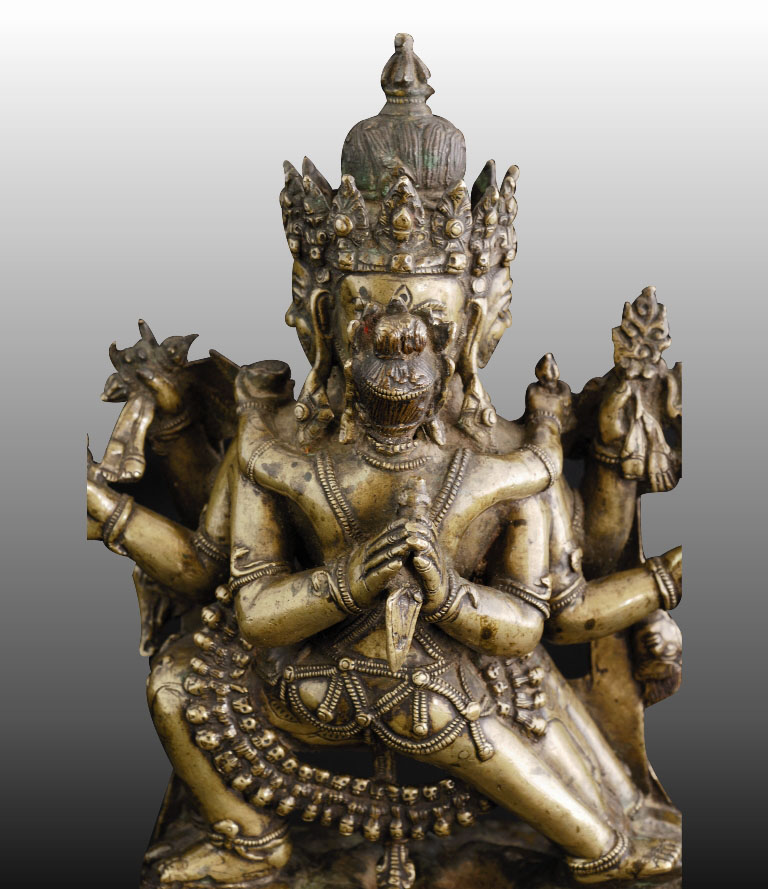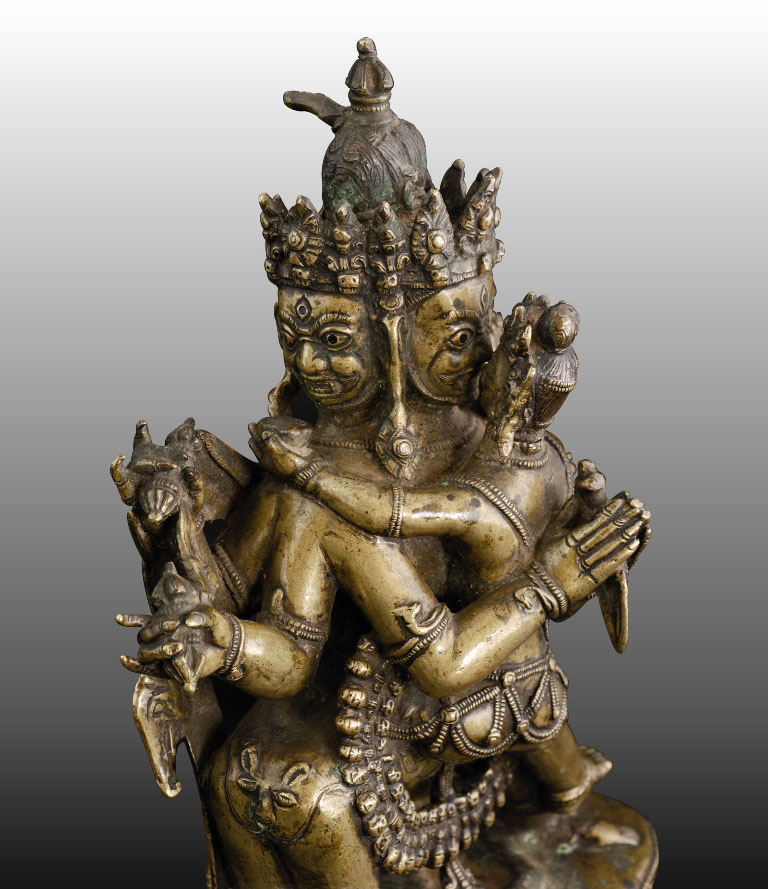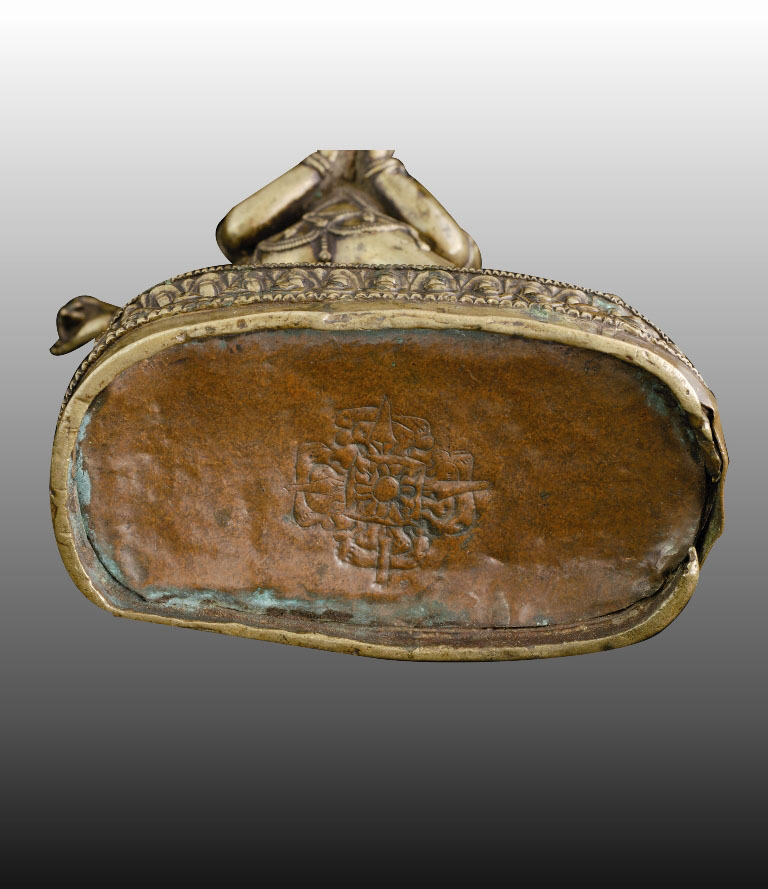|
|
«« go back
Vajrakîla
South-west Tibet - Brass - Height 24 cm - 15th century
Vajrakîla represents the anthropomorphic manifestation of the Indian ritual peg, kîla, which the god holds in his main hands. An ancient legend from the Vedic period tells how, before the birth of the world, the demiurge Indra used the kîla as a weapon to kill the primordial cosmic snake in whose coils the “waters of life” (1) were imprisoned. Thus the kîla incarnates a kind of paradox. On the one hand, it is the weapon which inflicts death, on the other it bestows life. In the same legend, Indra uses the kîla once again to separate the earth from the sky and, in relation to this episode, such object begins to symbolize both: the earth with the lower part, the point of which ensures stability; the sky with the upper part, where the gods reside. This Hindui legend was taken up by Buddhism, within the sphere of which the kîla became extremely important. That is true especially in the tantric context which provides for the worship of the esoteric deity Vajrakîla, who personifies this powerful magical, ritual tool.
During the initial stage of assimilation of the kîla in Buddhist practices, Indian monks used this tool to set down the limits of the space in which they would take refuge during the monsoon season, and make it impregnable against the hostile forces of the demon Mâra, untiringly devoted to deterring the monks from their meditative retreats. The first kîlas used for such purpose by the followers of Buddhism were made out of wood, and were planted in the ground and connected one to the other with a rope. In that way, they created an enclosure which marked off a sacred space with a centralized plan. Still today, every ritual practice requiring such space uses kîlas to mark it out and defend its boundaries. One of the best-known practices which makes the use of ritual pegs essential is that of the mandala of coloured sand, in which they are used both for protecting the space on which the drawing is to be produced and to fasten it to the sacred surface once completed.
The other attributes provided for by the iconography of Vajrakîla are two vajras, with nine and five points respectively, as well as a third, of which only one of the two ends is visible, set on the top of his bun of hair. A trident and a small flame are added to those attributes. The latter aims to evoke the power derived by his gesture of pointing his forefinger threateningly (tarjanî-mudrâ). The three faces of Vajrakîla identify as many characteristics of his potential: the central face, dark blue according to his iconography, has the faculty of thwarting ignorance; the one on the right, white in colour, can dispel the afflictions caused by anger; the red one on the left is able to remove all the impurities produced by desire. His six arms symbolize his ability to free beings and his four legs sym- bolize his ability to prevent the four inauspicious rebirths. A double cloak is visible behind him made of flayed human and elephant skins, held tight and showing limbs, legs and heads. Generally the iconography of Vajrakîla also provides for the presence of powerful unfurled wings, absent in this image, or more likely lost, which could be hooked onto the metal segment located behind the nape of his neck. The same segment was used to hold up the halo of flames, also lost, which normally surrounds the protectors of the doctrine and, more generally, wrathful deities. Vajrakîla, here joined sexually with his tantric companion who, in turn, holds a vajra and a kapâla (see no. 6), plays an important role especially within the tradition of the “Ancient” (rNying-ma) teachings, but also in that of the mon- astery of Sakya (Sa-skya) and in the school of the “Model of Virtue” (dGe-lugs-pa), which is led by the Dalai Lamas. The image has been produced in a style and with a metal alloy, brass, which are characteristic of the religious and artistic environment which developed in areas administrated by the religious order of Sakya, especially in south- west and southern (2) Tibet. The artistic trend ascribable to this cultural area can be recognized thanks to some recurrent stylistic elements: the string of pearls produced by means of small vertical engravings, decorating the lotus shaped base; the special kind of double, elongated petal, thin in shape, which forms the double lotus corolla; and the pupils of the eyes obtained by piercing small holes and filling them with a precious metal alloy.
(1) Martin J. Boord, The Cult of the Deity Vajrakîla, According to the Texts of the Northern Treasures Tradition of Tibet (Byang- gter phur-ba), The Institute of Buddhist Studies, Tring 1993, p. 39.
(2) Cfr. Erberto Lo Bue, Tibet dimora degli dei, La Rinascente, Milano 1991, p. 44.
For a similar Bronze figure: Carolyn Haloert Collection p.10 David Weldon-Jane Casey Carlton Rochell LLTD Von Schroeder(2001), no. 325B-C; Cornu(2001), p.649 Reynold, Heller, Gyatso (1986), pages 77-78; Pal (1983), pages 208-09; Essen and Thingo (1989), pages 170-72
|







